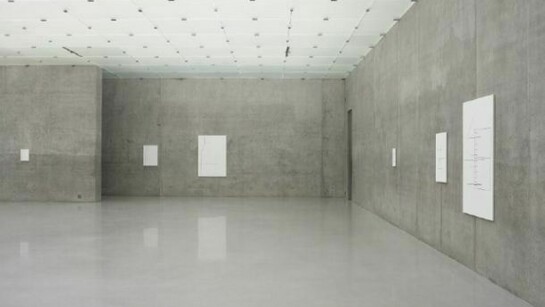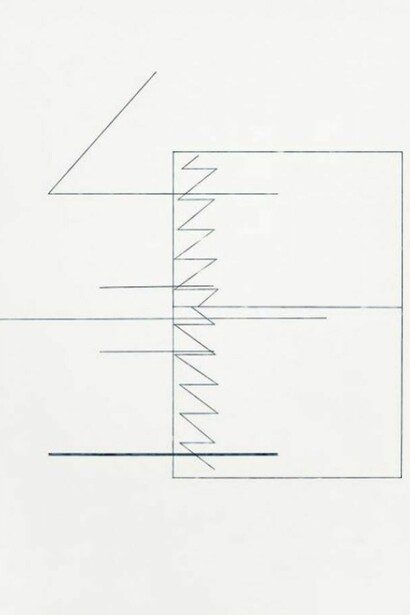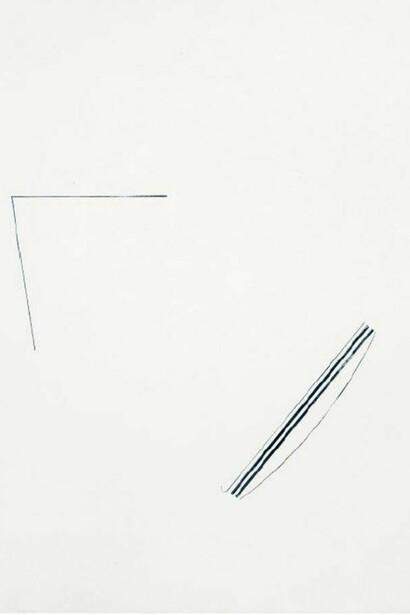Florian Pumhösl’s five series of Clichés (2012), debuting in London, were created using a stamping implement of the same name, itself an onomatopoeic French word that describes the ‘cliché’ sound a metal press makes each time it is struck in the printing process.
Each Cliché work is formed of three plaster panels that progress in size, with the gaps between the works also growing exponentially. Unlike traditional triptychs, these trios appear to be identical in their minimalist visual language, despite their leaps in scale, as if each design had been rescaled and reproduced in triplicate. This seriality is also evident in the formal patterns that dance across the plaster panels, the whole installation recalling a musical score or a time-based sequence.
Aside from references to early Modern art, Pumhösl’s stamp paintings display his interests in pre-Columbian textile patterns and three-dimensional architectural space. For his latest series, the artist has stamped old Georgian script on to plaster using the same printing block method, effectively reproducing obsolete letters from an alphabet that are unreadable to all but scholars of Aramaic or ancient Greek.
Whether the starting point is typography or textiles, Pumhösl creates a new vocabulary at one remove from recognition. He describes his quest to transform images and objects into elegant and spare arrangements as one of a struggle with the medium of mass-reproduction: “Whatever abstraction might represent historically, to me it is a tool to measure my freedom”.
Florian Pumhösl processes the tropes of art, architecture and graphics of the modernist avant-garde to create new aesthetic systems through painting, film and installation. He addresses the legacy of modernism through its canon of abstract visual language, from utopian architectural plans and buildings to innovations in publishing, the politics implicit in exhibitions and the motifs of early experimental filmmaking. In a series of minimal glass paintings, previously shown at the Lisson Gallery geometrical shapes float in space, while their titles – including Plakat (Poster), Seite (Page) and Aushang (Notice) – identify the shapes as reductions of typographical elements from the 1920s. Where their original function was to aid interpretation of a text, here they are devoid of text and interpretation proliferates.
In OA 1979-3-5-036 (2007), Pumhösl converted a 17th-century Japanese Kimono pattern catalogue into a 16mm animated film, selecting, simplifying and rearranging the patterns in order to ultimately arrive at a typology of fragments. Again, the title grounds the work in research: it is the British Library catalogue number for the original source. Moving between countries and media, Pumhösl picks up the skins shed between prototypes and artefacts, in readings that undermine the possibility of closed cultures.
Lisson Gallery
52-54 Bell Street
London, NW1 5DA United Kingdom
Ph. + 44 (0)20 77242739
contact@lissongallery.com
www.lissongallery.com
Opening hours
Monday - Friday from 10am to 6pm
Saturday from 11am to 5pm
Related images
- Florian Pumhösl, Cliché 10, 2012, Stamping with oil paint on ceramic plaster, three parts, © the artist; Courtesy; Lisson Gallery, London
- Florian Pumhösl, Cliché 7, 2012, Stamping with oil paint on ceramic plaster, three parts, © the artist; Courtesy; Lisson Gallery, London
- Florian Pumhösl, Cliché 8, 2012, Stamping with oil paint on ceramic plaster, three parts, © the artist; Courtesy; Lisson Gallery, London











